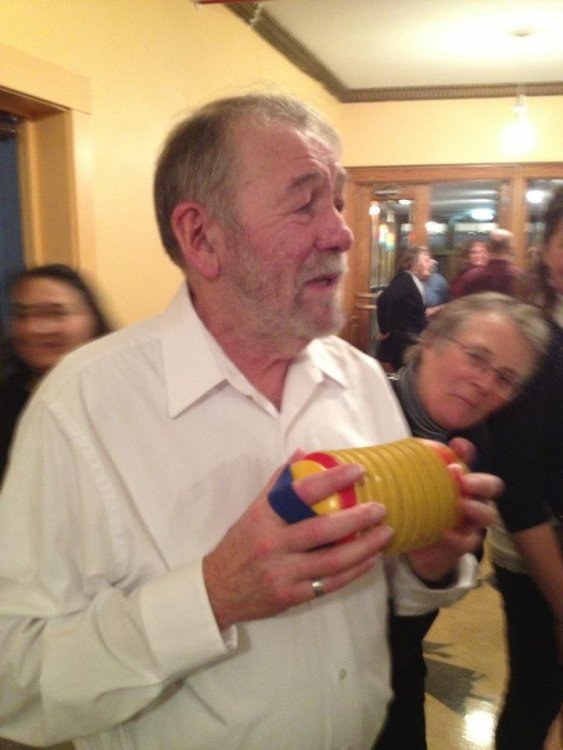-
Posts
280 -
Joined
-
Last visited
wayman's Achievements

Chatty concertinist (4/6)
-
rayhomewood started following wayman
-
On my first couple visits to Sheffield, I recorded sessions on my phone so I could learn what seemed to be "the normal Sheffield local session tunes" for my next visit. When I returned after another six months, I found the repertoire - at the very same session! - was completely different. Part of this was down to the earlier sessions being melodeon-heavy (and chock-full of John Spiers and Andy Cutting material) and the later sessions being fiddle-heavy (and ... not), but a larger part of it (I learned with still more years of visiting / living in Sheffield and going to the same sessions there) is that tunes really go in and out of fashion in a big way. Whatever was on the latest Leveret album, or whatever Topette uploaded to Youtube last month, will be really hot for a while, and then nobody wants to play it again for a year. But then, everybody knows it and it's fine to bring it up again after a while. While tunes that would make most "top ten English session tunes" lists (eg, Speed the Plough) pretty much never seemed to get played at that session unless they were started and very quickly turned into parodies of themselves as a big in-joke. So I guess my advice is, listen to the stuff on English albums that were super-popular from about ~5-10 years ago and learn some stuff from there. Like, pretty much anything off New Anything (Leveret) or Tunes (Spiers & Boden) are likely to be known by many people and yet are probably old enough that they haven't been played at every session for the past three months.... But better still, just be prepared to sit back, follow, and learn new tunes, and, yeah, if you get asked "lead something from back home", have a good 'un or two of those in your pocket that are easy for everyone to pick up or groove on. The overall English session vibe, if there is one, is "tunes where you can improvise around the melody" ?
-

Jody's next CD, TRAIN ON THE ISLAND
wayman replied to Jody Kruskal's topic in General Concertina Discussion
Well I hope you're bringing some to Vermont this weekend, Jody! See you Saturday on Elliott Street for a business transaction? (or "trainsaction"?) [oh, wait, more careful reading and now I see the "next month"... guess I'll be waiting on the platform for this train for a little while...] -
Also, here's the Folk London Club Guide (last updated a few weeks ago, so seems to be well-curated and likely reliable!).
-
First Sunday (so, the 3rd of June this year) at the Horseshoe, from noon to three or so. This session had maybe half a dozen concertinas of all systems, plus me and Jim Besser, last June. Very friendly and welcoming, great tunes (if you like English tunes!).
-

Reed Chamber Length Experiment
wayman replied to alex_holden's topic in Instrument Construction & Repair
I think the Dipper baritone I looked at had differently-sized pad holes, and I made measurements / notes about this, though I don't think I did experimentation about how this affects reed response... and I hadn't even considered the possibility of a differently-shaped hole (so the same amount of air can travel through it, while none of it gets too much of a "head start" towards the tip end of the reed). Nice insight, and I'd love to see whether that idea bears fruit. Another project for someday, if you don't experiment with it first... ? W -

Reed Chamber Length Experiment
wayman replied to alex_holden's topic in Instrument Construction & Repair
Good spot, Adrian. This would corroborate my findings that the length of air travel made more difference than the total size of the chamber in the ESB prototypes... Okay, it seems like I will have a new hobby the next time I'm back in the UK where my test bellows live, Dana! Not quite as crazy as the guy who carried a piano up Ben Nevis, but definitely a bit out of the ordinary... It'll give me a good excuse to do some hill climbing ? W -

Reed Chamber Length Experiment
wayman replied to alex_holden's topic in Instrument Construction & Repair
Dana, that's brilliant! I love it! In the 38-key Jeffries, there's a button on the left which is Bb below middle C on the draw and Bb an octave higher on the push. They never feel or sound quite the same, and I've always wished I had a solution to that. I don't really want to monkey with a Jeffries reedpan in that way, but I'll keep this in mind for future efforts of my own. -

Reed Chamber Length Experiment
wayman replied to alex_holden's topic in Instrument Construction & Repair
Now I want to take a test bellows and variable-chamber-size jig and various reeds to different altitudes (with greatly different air pressures) and collect lots more data! ? Imagine the other mountain climbers wondering what the heck you're doing up there, when you get to the summit and set up your test bellows... ? -

Reed Chamber Length Experiment
wayman replied to alex_holden's topic in Instrument Construction & Repair
Frank, is it strictly the size of the chamber (the volume of air in the chamber) that makes the difference? In my experience, if the chamber is longer than the reed, but the tip of the reed isn't all the way at the one end of the chamber and the pad hole isn't all the way at the other end of the chamber, the extra length of the chamber doesn't make nearly as much difference, no matter how much longer it is. That makes me think it's less about the volume of air in the chamber - and hence air pressure, though that may be a distinct factor - as about how far the air travels. But because the physical dimensions of the concertina are a limiting factor (if you want to keep it to a 6 1/4 or 7 inch instrument), sometimes making the chamber deeper is the only way to enlarge the chamber, and that does make some difference, just not as great a difference. -

Reed Chamber Length Experiment
wayman replied to alex_holden's topic in Instrument Construction & Repair
I've got reedpans for a large Wheatstone Maccann from the 1920s, and reedpans for a Lachenal baritone anglo from who knows when, where on the left side, the plane of the reedpan is not parallel to the plane of the action board: the chambers get progressively deeper from the end with the higher notes to the end with the lower notes, and it's a pretty big difference (the lowest chambers are probably 1/4 or 3/8 inch deeper than the highest chambers). I've never seen this done on the right side reedpan of a Maccann or anglo, though that's perhaps because the reeds are a bit less "in pitch order" on the reedpan. But on my G/D Jeffries, a previous owner (Robin, this was you who did this, right?) shortened the chamber of one of the highest reeds on the right side by filling the back end of the chamber with blu-tac, and that does seem to increase the response of the reed! (There's a thread here, from about five or six years ago, where Robin and Adrian discuss this at some length.) -

Reed Chamber Length Experiment
wayman replied to alex_holden's topic in Instrument Construction & Repair
(I then used these findings to redesign the reedpan for the Georgie baritone (English) model, lengthening as many of the chambers as we could make space for, and it dramatically improved the response of the lowest half-octave of that instrument! So these experiments with chamber length are very worthwhile.) -

Reed Chamber Length Experiment
wayman replied to alex_holden's topic in Instrument Construction & Repair
Very nice jig, Alex! I made something very similar when the Button Box was designing the Morse ESB (baritone anglo model), and then took the data I gathered (on lengths that seemed to work well in practice for various pitches) and tried to come up with an algorithm that described the data. I recall getting somewhere roughly with that, but given that I'd already done the empirical research which definitely worked on a prototype reedpan, there wasn't really a need to perfect an algorithm. This (as demonstrated in instruments on three successive full prototype reedpan designs with different chamber lengths) made an enormous difference in the performance and sound of the instrument. I was guided by a Dipper baritone that had conveniently come in for repairs just as I was starting to think about ideal chamber lengths for reeds. I measured its chambers; the one thing I remember is that there were (unsurprisingly) some differences in actual length / air volume for chambers that seemed to work with hybrid vs concertina reeds, but also (unsurprisingly) the trend in each was pretty similar in the ratios of air volumes between pitches. -
Folk music is rarely as simple as many people think it is! I simplified my explanation of the "three melodic notes" to "scale tones 1,2,3 of a minor scale" just to quickly describe the melody but you're right, technically it's NOT that, and whatever it is, the "complicated whatever" is what makes the Watersons' recording so good. I want to sit down with this at some point and figure out what the Watersons are actually doing sometime. The simpler the tune, the more varied the ways you can mess around with harmonies... Another three-note tune (maybe song? are there lyrics?) that's similar (at least thematically in title) is "Hot Cross Buns", which might be Suzuki book 1 tune 1 or 2, one of those things kids learn at age three and then never play again.... Christian religious baked goods seem to get celebrated with three-note melodies for whatever reason!!! (Anyone know a three-note song about communion wafers?) For a Christian religious baked goods song with many more notes in the melody, seek out Rosie Hood's recording of "Baker's Oven" (the only recording I or Mainly Norfolk know of this song; lyrics here though to hear it I think you'll have to buy the album or song, or better still hear Rosie live sometime - all worthwhile experiences, especially if you catch her current dual-bill tour with Cohen Braithwaite-Kilcoyne, to work some concertina content into this post).
-
A soul, a soul, a soul cake, Please, good missus, a soul cake, An apple, a pear, a plum or a cherry, Any good thing to make us merry. One for Peter, two for Paul, Three for Him that made us all. (As sung by the Watersons) It's just the first three notes of the minor scale. Six years ago I handed John Roberts a toy concertina with zero buttons, rubber bellows, and one diatonic reed on each side, just to see what he'd do with it. This was at the intermission of a Nowell Sing We Clear performance, in the theatre lobby. And he immediately launched into the souling song, and it was perfect.





